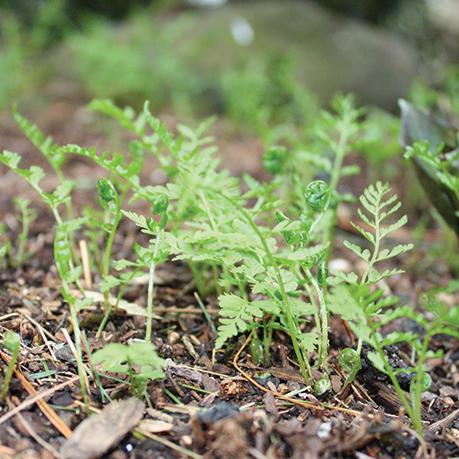

























WELCOME TO THE WOODS PATH
This area features a mature tulip tree canopy, a diverse array of understory trees and shrubs, and an intricate herbaceous layer. The plant selections are a rich tapestry of flowers, foliage, and textures, especially in the spring.
The combinations along the main pathway are designed to highlight a continuous display of seasonal interest. Evergreen and deciduous plantings create visual separation between this and other areas of the garden.
Check out our Staff Picks, selected by Sean Camilleri, Senior Horticulturist! These are Sean’s favorite plants on the Woods Path.
Actaea racemosa
Amelanchier canadensis
Aquilegia canadensis
Aralia racemosa
Carya ovata
Cystopteris protrusa
Deparia acrostichoides
Eurybia divaricata
Geranium maculatum
Heuchera americana
Hydrangea quercifolia
Ilex verticillata
Impatiens capensis
Leucothoe fontanesiana
Lilium superbum
CHARACTERISTICS
Liriodendron tulipifera
Onoclea sensibilis
Osmunda spectabilis
Pachysandra procumbens
Phegopteris hexagonoptera
Polemonium reptans
Rhododendron austrinum
Rhododendron maximum
Solidago flexicaulis
Herbaceous (Not Woody)
Pollinator Significance
Deer Resistant
black bugbane
Canadian serviceberry
wild columbine
American spikenard
shagbark hickory
lowland bladder fern
silver false spleenwort
white wood aster
wild geranium
American alumroot
oakleaf hydrangea
winterberry
orange jewelweed
drooping leucothoe
Turk’s cap lily
tulip tree
sensitive fern
American royal fern
Allegheny pachysandra
broad beech fern
Jacob’s-ladder
Florida flame azalea
rosebay rhododendron
goldenrod
RESEARCH
Dig in to past Trial Garden research reports at mtcubacenter.org/trial
EDUCATION
Classes and lectures on horticulture, native plants, conservation, art, and wellness are offered year round. Learn more at mtcubacenter.org/programs
Upright habit; slow to establish
Attractive landscape shrub or small tree; edible fruits
Thrives in well-drained, rich soils with some shade
Large herbaceous perennial; ornamental red fruits
Deep taproot makes transplanting difficult; great fall color
Forms large colonies; foliage gone by summer
Spores on leaf undersides ripen from silver to brown
Tolerates shallow, rocky soils; readily self-seeds
Tolerates poor soils; spreads via rhizome and seed
Semi-evergreen; specialist bee host plant
Showy flowers; exfoliating bark provides winter interest
Ornamental red berries; need male and female for pollination
Annual; remains in landscape through self-seeding
Can be massed for a low, evergreen screen; intolerant of drought
Slow spreader; requires several years to flower from seed
Fast-growing; straight, unbranched trunk
Foliage dies after frost; fertile fronds persist through winter
Clump forming; yellow-bronze fall color
Semi-evergreen groundcover; fragrant flowers
Spreads by roots to form large colonies with time
Self-seeds in optimum growing conditions
Intolerant of drought and poorly-drained soils; shallow root system
Evergreen; intolerant of drought and poorly-drained soils
Keystone species; tolerates clay soils; prefers dappled sun
RESOURCES
For a list of businesses that sell native plants or seeds, visit mtcubacenter.org/directory
